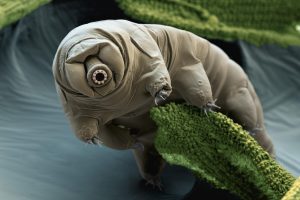Bioluminescence – Part 10
 Have you ever heard of a tardigrade? That’s this piggy-looking fellow with the nozzle mouth to the right. Tardigrades are microscopic eight-legged animals that are sometimes called “water bears.” They have a tough outside shell like a beetle, and up to six claws on each foot. Their mouth is used to bore into plants and suck the juices. These little critters are incredibly resilient. Tardigrades have been known to last as long as 30 years without food or water. They can survive extreme temperatures, from absolute zero to boiling. They can handle pressures 6X that of the deepest ocean as well as the vacuum of outer space. In drought, they can retract their heads and limbs into a tiny little ball, and become dormant. But perhaps the most interesting survival ability is to glow. That’s right, they are able to use bioluminescence to render ultraviolet radiation harmless. Certain species of tardigrade can survive intense UV for over an hour by glowing in the dark. Scientists do not yet understand how light can be a UV buffer, but somehow it acts like a shield. This reminds that “if we walk in the light, as he is in the light, we have fellowship one with another, and the blood of Jesus Christ his Son cleanseth us from all sin” (I John 1:7).
Have you ever heard of a tardigrade? That’s this piggy-looking fellow with the nozzle mouth to the right. Tardigrades are microscopic eight-legged animals that are sometimes called “water bears.” They have a tough outside shell like a beetle, and up to six claws on each foot. Their mouth is used to bore into plants and suck the juices. These little critters are incredibly resilient. Tardigrades have been known to last as long as 30 years without food or water. They can survive extreme temperatures, from absolute zero to boiling. They can handle pressures 6X that of the deepest ocean as well as the vacuum of outer space. In drought, they can retract their heads and limbs into a tiny little ball, and become dormant. But perhaps the most interesting survival ability is to glow. That’s right, they are able to use bioluminescence to render ultraviolet radiation harmless. Certain species of tardigrade can survive intense UV for over an hour by glowing in the dark. Scientists do not yet understand how light can be a UV buffer, but somehow it acts like a shield. This reminds that “if we walk in the light, as he is in the light, we have fellowship one with another, and the blood of Jesus Christ his Son cleanseth us from all sin” (I John 1:7).
Posted on February 2, 2021 by dwoetzel.
